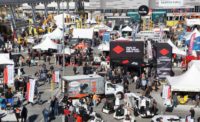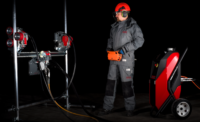New Machines and a Positive Outlook at World of Concrete

Concrete Jungle Zigzagging pump booms loom overhead as attendees flock to see the latest concrete equipment and tools on display at World of Concrete 2016, held in Las Vegas on Feb. 2-5. Photos by Jeff Rubenstone for ENR

Brick and Mortar Competitors from around the world rush to build the biggest wall they can in the Spec Mix 500 World’s Best Bricklayer contest. Photos by Jeff Rubenstone for ENR


With a new multiyear highway bill passed and other positive economic indicators boosting morale, crowds poured into Las Vegas on Feb. 2-5 for the World of Concrete show.
Some unusually chilly temperatures didn’t deter attendance, which was up an estimated 8% to 10% over 2015’s 55,000 attendees. According to event organizers, the show’s size almost has recovered to pre-recession, pre-2008 levels. “[Attendance] is up over last year, and we have more than 1,525 exhibitors,” says Steve Pomerantz, senior marketing manager for World of Concrete. “It’s our largest event in seven years, with over 700,000 net square feet.”
Attendees looking for some good news were buoyed by a positive economic forecast from the Portland Cement Association. Chief economist Edward Sullivan says he expects 5% year-over-year growth in cement consumption in 2016, crediting a boost in highway spending from the recently enacted FAST Act as well as signs of pent-up demand in the housing sector. “This spending will help to overcome the effects of inflation and also offset the drag due to low oil prices,” he says. “The FAST Act should be praised.”
With the triennial Bauma equipment show set for Munich in April, some major equipment manufacturers chose to hold off new product launches at World of Concrete. But there were still plenty of new machines and tools on the show floor as well as outdoor lots for attendees to climb over and test themselves.
In addition to unveiling its new line of compact loaders, Deere & Co. also showed off its upgraded 700K dozer with integrated machine controls. The sensors and satellite radio of a Topcon 3D MC² system are fully encased within the body and blade of the dozer, rather than mounted on a removable mast. “Our customers said, ‘Get rid of the mast, get rid of the cables and integrate this into the dozer,’ ” says William Bauman, an instructor with Deere’s WorkSight program.
Linmar Corp.’s Skyjack division recently changed the diesel engines in its large telehandler range. It reduced the rated horsepower below the EPA’s 75-hp cutoff, thus avoiding costly emissions after-treatment systems. The new models run on 74-hp Deutz engines but retain much of the same power as earlier models, thanks to improved gearing, high-torque engines and simplified hydraulics.
Liebherr, based in Germany, is expanding its concrete business in North America, bringing in its truck-mounted 37 Z4 XXT concrete pump. All four of the pump’s outriggers are connected directly to the boom pedestal for stability, allowing it to pump at full extension even when the outriggers are pivoted at odd angles. “Our pump’s unique outrigger system can work well on crowded sites,” says Alexander Kuhn, head of U.S. sales for Liebherr’s concrete technology division. “Right now, we see North America as a good market for concrete pumps.”
New advances in concrete chemistry also were a draw at the show. Chemical giant BASF was touting the recent results of its strength tests on concrete pipe, using polypropylene fragments, rather than steel, as reinforcement. The study, conducted by University of Texas at Arlington researchers, found that concrete pipe with the synthetic macrofibers performed as well or better than traditionally reinforced concrete pipe. Based on the research, the new ASTM C1818 standard was published in December 2015. In certain applications, it allows for cheaper concrete pipes with synthetic fiber to be used in place of steel-reinforced concrete pipe. “This product will allow us to compete better in private markets,” says Matt Childs, president of the American Concrete Pipe Association. “We can now do things to change an industry that’s been doing things the same for 100 years.”







